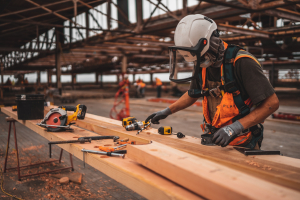
Durability Matters: How to Choose Workwear That Lasts
When it comes to workwear, durability is a crucial factor to consider. Your team relies on their workwear to protect them, enhance their performance, and represent your brand. Therefore, choosing workwear that is built to last is of utmost importance. In this blog post, we will provide you with a comprehensive guide on how to choose workwear that is durable and can withstand the demands of your industry, ensuring that your investment lasts.
Consider the Fabric
One of the most important factors in determining the durability of workwear is the fabric it is made from. Different fabrics have varying levels of durability and performance. Here are some fabric options to consider:
1. Cotton: Cotton is a popular choice for workwear due to its breathability and comfort. However, it may not be the most durable option, especially in high-stress environments.
2. Polyester: Polyester is known for its strength and resistance to abrasion. It is a durable fabric that can withstand rugged conditions and frequent washing. Additionally, it is quick-drying and resistant to shrinking and wrinkling.
3. Blended fabrics: Blended fabrics, such as cotton-polyester blends, combine the best qualities of different materials. They offer a balance between durability, comfort, and performance.
When choosing a fabric, consider the specific needs of your industry and the tasks your employees perform. If they are exposed to harsh conditions or require heavy-duty workwear, opt for fabrics that are known for their durability and resistance.
Evaluate Construction and Reinforcement
In addition to the fabric, the construction and reinforcement of workwear also play a significant role in its durability. Look for the following features when evaluating the construction of workwear:
1. Double or triple stitching: Workwear with double or triple stitching is more resistant to tearing and can withstand the strain of repetitive movements.
2. Reinforced knees and elbows: These areas are prone to wear and tear, especially in industries that involve kneeling, bending, or leaning. Workwear with reinforced knees and elbows can prolong the lifespan of the garment.
3. Bar-tacked stress points: Bar-tacking is a reinforcing technique that involves stitching across stress points to prevent ripping or tearing. Look for workwear that has bar-tacked stress points, such as pockets or seams.
By paying attention to the construction and reinforcement of workwear, you can ensure that it is designed to withstand the rigours of your industry and provide long-lasting durability.
Look for Quality Brands and Suppliers
Another crucial aspect of choosing durable workwear is selecting reputable brands and suppliers. Quality brands often have a reputation for producing workwear that is built to last. They invest in research, development, and testing to ensure that their products meet industry standards and customer expectations.
When selecting a supplier, consider the following:
1. Experience and expertise: Look for suppliers with extensive experience in the workwear industry. They are more likely to have a deep understanding of the requirements and challenges of different industries.
2. Product guarantees and warranties: Suppliers that offer product guarantees or warranties demonstrate their confidence in the durability and quality of their workwear. This can provide you with peace of mind and assurance that your investment is protected.
3. Customer reviews and testimonials: Read customer reviews and testimonials to get insights into the experiences of other businesses that have used the supplier's workwear. Positive reviews can be a good indicator of the supplier's commitment to quality and durability.
By choosing reputable brands and suppliers, you can increase the likelihood of finding workwear that meets your durability requirements and provides long-lasting performance.
Consider Maintenance and Care
Proper maintenance and care are essential for prolonging the lifespan of workwear. Provide your team with guidelines on how to care for their workwear, including washing instructions, drying methods, and storage recommendations. Additionally, consider the following tips to maintain the durability of workwear:
1. Follow manufacturer's instructions: Always follow the care instructions provided by the manufacturer to ensure that the workwear retains its durability and performance.
2. Inspect and repair: Regularly inspect workwear for any signs of wear or damage. Address any issues promptly by repairing or replacing the garment to maintain its durability.
3. Rotate workwear: Encourage your team to rotate their workwear to distribute the wear and tear evenly. This can help extend the lifespan of the garments.
By implementing proper maintenance and care practices, you can maximise the durability and longevity of your workwear investment.
In conclusion, choosing workwear that is durable and long-lasting is essential for the safety, performance, and representation of your team. Consider the fabric, evaluate the construction and reinforcement, select reputable brands and suppliers, and implement proper maintenance and care practices. By finding the right balance between quality and cost, you can ensure that your workwear investment provides value and reliability for your team in the long run.




